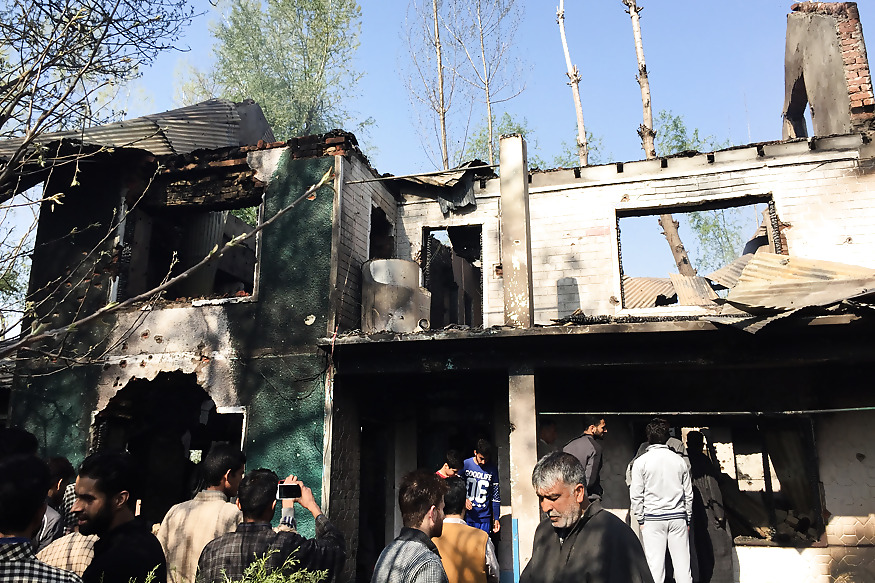
views
Shopian, Anantnag and Srinagar: Army and police personnel cordoned off a house in the dead of night on March 31 over inputs of militants present in Dialgam village of Anantnag district, southern Kashmir.
The inmates were asked to come out. The intelligence was specific about the presence of 20-year-old Hizbul Mujahideen militant, Rouf Ahmad Khanday and his associate. Both had picked up the gun only this winter. Forces managed to nab the associate alive but Khanday was ready for a fight.
“We didn’t want to kill him,” said Anantnag Senior Superintendent of Police, Altaf Ahmad Khan. A family member, whose house Khanday was supposed to be in, was sent inside to give him the phone.
Khan spoke with Khanday, trying to persuade him, quoting Islamic literature. “He didn’t listen to me,” Khan, who was at the spot, told News18.
A police party went to fetch Khanday’s parents from their home in Dehruna village, five kilometres from the spot. The parents came, pleaded with their son to surrender for half-an-hour but returned blank. Khanday had instead opted for death and told his father, Bashir Ahmad, “I want to be a martyr.”
At least 16 militants, who have picked up arms in the last three months, when engaged with forces in an encounter and beseeched by their family members, have actually dropped guns, say senior police officers. In most cases, though, militants have preferred to die fighting the forces.
After a few minutes, the gunfight with Khanday began. The double-story house caught flames, its walls and roof were felled with explosives. By dawn, the charred body of Khanday was retrieved from the debris and subsequently handed over to his family.
Later in the day, thousands thronged to the funeral and chanted anti-India slogans. A bearded man hailed Khanday for his “commitment”. His funeral prayers were led by his father — a carpenter by profession.

Funeral procession of 20-year-old Hizbul Mujahideen militant Rouf Ahmad Khanday.
Khanday, the youngest of six brothers, was a college student when he suddenly disappeared in January. His family waited for him for more than a month. “We searched for him but could not find him. Then we filed a missing complaint after more than a month,” said a family member of Khanday. A few days later, his gun-wielding picture confirmed the rumours that Khanday had joined the militancy.
Locals told News18 that it has been more than a decade since someone took arms in Dehruna village. This is a village where nobody picked up weapons against the state even in 2016 when local militancy in Kashmir saw a huge surge following the death of Burhan Wani – the poster boy of Kashmiri militancy. Dehruna is close to Bamdoora, where Wani was shot dead by security forces.
Villagers say there is no apparent explanation for Khanday joining Hizbul. “He was bright and educated but militancy is what he found a future in,” said a friend of Khanday.
Khanday’s story is worrying because it shows how places that till now remained insulated from violence are seeing youths pick up guns.
Considering that there has been no apparent trigger, such as Wani’s death, stories of youth joining the militancy is alarming.
Official figures provided by the state police say 27 local boys have already joined the militants this year. In other words, one local Kashmiri boy is picking up arms every third day.
Last year too, around 127 boys picked up guns in the valley. The same ‘one every third-day’ pace. Sources, however, claim that the actual recruitment this year is significantly higher considering the number of “missing persons” report filed across the valley, many of whom are believed to have joined militancy.
A senior police officer, who has led counter-insurgency operations in the valley, said, “There are a lot of such cases where families have lodged missing person complaints. After complete investigation and profiling, we have found that these are active militants. So, there is a strong possibility that many of the youngsters, who have gone missing, have actually joined militancy.”
“Local youth taking up arms is a challenge for everyone,” police chief Vaid told New18. “Civil society, political class, police and everyone else has to come together to save our youth.”
What is also a great cause of concern for security agencies is the number of highly educated youths joining militant ranks.
Among the militants killed in Kashmir on Sunday, one was M. Phil scholar. In January this year, 26-year-old PhD scholar Mannan Bashir Wani, hailing from Kupwara district and studying in Aligarh Muslim University (AMU), joined Hizbul Mujahideen.
Militants are cropping up not just from households of ordinary citizens. On March 24, hours after top separatist Muhammad Ashraf Sehrai was appointed Tehreek-i-Hurriyat chairman, his youngest son Junaid Ahmad Sehrai (30) joined Hizbul Mujahideen. He was an MBA from the University of Kashmir and worked for an e-commerce company.
“There is a sophisticated network of these radicalised youth. When a slain militant is received as a hero, other youth, to give way to their anger, follow the same path,” said a police official.
Most local militants are not well-trained and mostly die in encounters without any tough fight.
“Militancy is not reducing because there are Over Ground Workers (OGW’s), who are waiting for their turn to join the ranks following the death of a militant,” the official said.

The house where an encounter took place between militants and police in Dialgam village of Anantnag district in southern Kashmir.
While most of the youth are joining Hizbul, recently though, there have been cases of youth being driven to a global radical Islamist narrative.
On March 12, three militants — Eisa Fazili of Srinagar, Syed Owais Shafi of south Kashmir’s Kokernag and Mohammad Taufeeq, a Telangana resident — were killed in Hakhoora Anantnag. Both Fazili and Shafi, before joining militancy, were studying engineering at Baba Ghulam Shah Badshah (BGSB) University in Rajouri.
Social media accounts affiliated with terror outfit Islamic State and Ansar Ghazwat-ul Hind (AGuT) backed by Al-Qaeda, claimed the three militants belonged to their outfits.
“I think these youth were attracted by the global trend. Extremism can be seen all over,” says another police official, posted in South Kashmir. “Moreover, there are no concrete efforts of peace. Killing a militant is giving birth to more.”
Compared to the scale and impact of the militancy in the 1990s, the new-age of militancy can in many ways be described as a low-intensity conflict, says Srinagar-based journalist Gowhar Geelani.
“However, the overt support for local armed rebels is unprecedented. This needs to be understood and analysed in a given context,” says Geelani. “The present situation highlights the failure of the politics and the fact that absence of meaningful political intervention in Kashmir is a ticking bomb.”
Senior PDP leader Waheed-ur-Para admits that the situation is deteriorating rapidly and it is time for the Centre to intervene while showing its softer side. He suggests that only killing militants may not be a solution to discouraging youths from picking up weapons.
“There is no victory for us in a death of a young boy. Violence cannot be the answer to violence. More important is that we show outrage when boys are joining these militant groups. It is a cause for concern. One dead body overshadows everything, every peace process.”
Para adds that it is a cause of alarm that youth finds dying attractive. “We have to think about how to make democracy more attractive. I am of the opinion that the power to do so lies with New Delhi. Centre has to do it like it happened in 2002 when it supplanted its encounter killings with an active surrender and rehabilitation policy.”
In many ways, Para’s opinions reflected those of the former Chief Minister and senior National Conference leader Omar Abdullah.
“Is no one in a position of power in Delhi alarmed by this because I certainly am!" Abdullah wrote on his Twitter account in reaction to the April 1 encounters. He said the massive jump in the number of young Kashmiri men joining the ranks of militant organisations is the biggest and least talked about the failure of the incumbent Chief Minister.

The house where an encounter took place between militants and police in Dialgam village of Anantnag district in southern Kashmir.
As per government data, a total of 66 Kashmir youth joined militant ranks in 2015. In 2016, the number surged up to 88. Furthermore, in 2017, 126 Kashmiri youth joined the militant ranks.
Two other aspects of the ongoing militancy are disconcerting. First, nearly half of the current militant strength in Kashmir – 250 — is local, which has not been seen in the valley in a long time. Most of them, around 40, have joined militant ranks from one district – Shopian – alone.
Second, almost as many militants that security forces killed in Kashmir in 2017 – around 200 – are back fighting the forces again. At least 70 militants from Jaish-e-Mohammed are believed to have infiltrated into Kashmir. Taking into account the current militant strength and local recruitment, the ongoing operations in Kashmir appear to be a zero-sum game.
In Shopian’s Eidgah, thousands gathered for the funeral of Zubair Turray, one of the thirteen militants killed on Sunday. Irshad Ahmad, a college student was part of his funeral. “They have killed Zubair but you will see the next Zubair coming up from this funeral only,” said an enraged Irshad. “You know, most of the militants who joined last year were part of Burhan Wani’s funeral. There is no threat of death, it is a sign of achievement.”
More than a hundred people sustained injuries while clashing with the forces near three encounter sites on April 1.
“The boys inside are our brothers,” said a sixteen-year-old, hit by pellets in face and chest. “I am injured but I will throw stones till I am not dead. We are all fighting for the same cause. They (militants) have guns, we have stones.”
A total of 21 people died during clashes between security forces and civilians who tried to help the militants escape. Five civilians, 13 militants and three army jawans died in Kashmir on April 1.
(The author is a Kashmir-based freelance journalist)


















Comments
0 comment